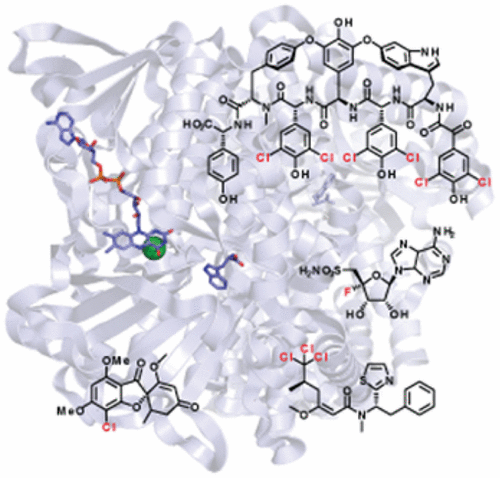当前位置:
X-MOL 学术
›
Chem. Rev.
›
论文详情
Our official English website, www.x-mol.net, welcomes your
feedback! (Note: you will need to create a separate account there.)
Development of Halogenase Enzymes for Use in Synthesis
Chemical Reviews ( IF 51.4 ) Pub Date : 2017-05-03 00:00:00 , DOI: 10.1021/acs.chemrev.7b00032 Jonathan Latham 1 , Eileen Brandenburger 1 , Sarah A Shepherd 1 , Binuraj R K Menon 1 , Jason Micklefield 1
Chemical Reviews ( IF 51.4 ) Pub Date : 2017-05-03 00:00:00 , DOI: 10.1021/acs.chemrev.7b00032 Jonathan Latham 1 , Eileen Brandenburger 1 , Sarah A Shepherd 1 , Binuraj R K Menon 1 , Jason Micklefield 1
Affiliation

|
Nature has evolved halogenase enzymes to regioselectively halogenate a diverse range of biosynthetic precursors, with the halogens introduced often having a profound effect on the biological activity of the resulting natural products. Synthetic endeavors to create non-natural bioactive small molecules for pharmaceutical and agrochemical applications have also arrived at a similar conclusion: halogens can dramatically improve the properties of organic molecules for selective modulation of biological targets in vivo. Consequently, a high proportion of pharmaceuticals and agrochemicals on the market today possess halogens. Halogenated organic compounds are also common intermediates in synthesis and are particularly valuable in metal-catalyzed cross-coupling reactions. Despite the potential utility of organohalogens, traditional nonenzymatic halogenation chemistry utilizes deleterious reagents and often lacks regiocontrol. Reliable, facile, and cleaner methods for the regioselective halogenation of organic compounds are therefore essential in the development of economical and environmentally friendly industrial processes. A potential avenue toward such methods is the use of halogenase enzymes, responsible for the biosynthesis of halogenated natural products, as biocatalysts. This Review will discuss advances in developing halogenases for biocatalysis, potential untapped sources of such biocatalysts and how further optimization of these enzymes is required to achieve the goal of industrial scale biohalogenation.
中文翻译:

用于合成的卤化酶的开发
自然界已经进化出卤化酶以区域选择性地卤化各种生物合成前体,引入的卤素通常对所得天然产物的生物活性产生深远影响。为制药和农业化学应用创造非天然生物活性小分子的合成努力也得出了类似的结论:卤素可以显着改善有机分子的特性,以选择性调节体内生物靶标。因此,当今市场上的大部分药品和农用化学品都含有卤素。卤代有机化合物也是合成中常见的中间体,在金属催化的交叉偶联反应中特别有价值。尽管有机卤素具有潜在的效用,传统的非酶卤化化学使用有害试剂并且通常缺乏区域控制。因此,用于有机化合物区域选择性卤化的可靠、简便和清洁的方法对于开发经济和环境友好的工业过程至关重要。这种方法的一个潜在途径是使用卤化酶作为生物催化剂,负责卤化天然产物的生物合成。本综述将讨论开发用于生物催化的卤化酶的进展、此类生物催化剂的潜在未开发来源以及如何进一步优化这些酶以实现工业规模生物卤化的目标。因此,用于有机化合物区域选择性卤化的更清洁方法对于开发经济和环境友好的工业过程至关重要。这种方法的一个潜在途径是使用卤化酶作为生物催化剂,负责卤化天然产物的生物合成。本综述将讨论开发用于生物催化的卤化酶的进展、此类生物催化剂的潜在未开发来源以及如何进一步优化这些酶以实现工业规模生物卤化的目标。因此,用于有机化合物区域选择性卤化的更清洁方法对于开发经济和环境友好的工业过程至关重要。这种方法的一个潜在途径是使用卤化酶作为生物催化剂,负责卤化天然产物的生物合成。本综述将讨论开发用于生物催化的卤化酶的进展、此类生物催化剂的潜在未开发来源以及如何进一步优化这些酶以实现工业规模生物卤化的目标。作为生物催化剂。本综述将讨论开发用于生物催化的卤化酶的进展、此类生物催化剂的潜在未开发来源以及如何进一步优化这些酶以实现工业规模生物卤化的目标。作为生物催化剂。本综述将讨论开发用于生物催化的卤化酶的进展、此类生物催化剂的潜在未开发来源以及如何进一步优化这些酶以实现工业规模生物卤化的目标。
更新日期:2017-05-03
中文翻译:

用于合成的卤化酶的开发
自然界已经进化出卤化酶以区域选择性地卤化各种生物合成前体,引入的卤素通常对所得天然产物的生物活性产生深远影响。为制药和农业化学应用创造非天然生物活性小分子的合成努力也得出了类似的结论:卤素可以显着改善有机分子的特性,以选择性调节体内生物靶标。因此,当今市场上的大部分药品和农用化学品都含有卤素。卤代有机化合物也是合成中常见的中间体,在金属催化的交叉偶联反应中特别有价值。尽管有机卤素具有潜在的效用,传统的非酶卤化化学使用有害试剂并且通常缺乏区域控制。因此,用于有机化合物区域选择性卤化的可靠、简便和清洁的方法对于开发经济和环境友好的工业过程至关重要。这种方法的一个潜在途径是使用卤化酶作为生物催化剂,负责卤化天然产物的生物合成。本综述将讨论开发用于生物催化的卤化酶的进展、此类生物催化剂的潜在未开发来源以及如何进一步优化这些酶以实现工业规模生物卤化的目标。因此,用于有机化合物区域选择性卤化的更清洁方法对于开发经济和环境友好的工业过程至关重要。这种方法的一个潜在途径是使用卤化酶作为生物催化剂,负责卤化天然产物的生物合成。本综述将讨论开发用于生物催化的卤化酶的进展、此类生物催化剂的潜在未开发来源以及如何进一步优化这些酶以实现工业规模生物卤化的目标。因此,用于有机化合物区域选择性卤化的更清洁方法对于开发经济和环境友好的工业过程至关重要。这种方法的一个潜在途径是使用卤化酶作为生物催化剂,负责卤化天然产物的生物合成。本综述将讨论开发用于生物催化的卤化酶的进展、此类生物催化剂的潜在未开发来源以及如何进一步优化这些酶以实现工业规模生物卤化的目标。作为生物催化剂。本综述将讨论开发用于生物催化的卤化酶的进展、此类生物催化剂的潜在未开发来源以及如何进一步优化这些酶以实现工业规模生物卤化的目标。作为生物催化剂。本综述将讨论开发用于生物催化的卤化酶的进展、此类生物催化剂的潜在未开发来源以及如何进一步优化这些酶以实现工业规模生物卤化的目标。











































 京公网安备 11010802027423号
京公网安备 11010802027423号